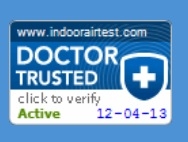News
The Hidden Dangers Lurking within the HVAC System
One emerging organisms is Staphylococcus aureus which has been isolated within the evaporator coils of HVAC systems.
According to a recent study supported by the US Army Material Command entitled Characterization and Control of the Microbial Community Affiliated with Copper or Aluminum Heat Exchangers of HVAC Systems, microbial growth within heating ventilation and air-conditioning (HVAC) systems with the subsequent contamination of indoor air is of increasing concern. Researchers reported microbial contaminants can result in numerous adverse effects on human health and well-being, including inflammation and infections. Airborne bacteria and fungi have the potential to adversely impact human health by causing infections, allergic responses, or toxic effects.
Dr. Rajiv Sahay, laboratory director with Environmental Diagnostics Laboratory (EDLab) an AIHA accredited lab of Clearwater, FL stated “not only do these inherent microbial conditions within HVAC systems impair the overall HVAC system efficiency thus causing unnecessary mechanical breakdowns, but it also creates an increase in the potential environmental health hazards”. Recent building closures in universities, schools and office buildings have been traced, in part, to the mechanical system operation and maintenance and the poor environmental conditions that exist within them. One emerging organisms is Staphylococcus aureus which has been isolated within the evaporator coils of HVAC systems.The introduction of new classes of antibiotics usually has been followed by the emergence of resistance in S. aureus. After the initial success of penicillin in treating S. aureus infections, penicillin-resistant S. aureus became a major threat in hospitals and nurseries in the 1950s, requiring the use of methicillin and related drugs for treatment of S. aureus infections. In the 1980s, methicillin-resistant S. aureus (MRSA) emerged and became widespread in many hospitals, leading to the increasing use of vancomycin. The first clinical isolated case of S. aureus with reduced susceptibility to vancomycin was reported from Japan.
A survey performed by the EDLab reported that Staphylococcus aureus is also a part of an indoor environment’s bacterial flora. These bacteria have been isolated both from air and surfaces (HVAC evaporator coils) during routine investigations of indoor environmental quality. They may be categorized as environmental or clinical based on their source. In either case, the existing environmental conditions such as temperature, humidity, natural mutagens etc. play an important role in the survival and virulence of these microorganisms. For example, the remediation of existing microorganisms in an indoor environment often leaves behind a small portion of biological debris. Depending upon the viability and stress of the microorganisms, some of them may regenerate and multiply to become part of the existing micro flora of that environment. Therefore, continuous surveillance is essential to monitor these infectious particles from the health and hygiene point of view in and around closed structures (home, offices, etc.).
Antibiotics do not technically cause a resistance, but can allow it to happen by creating a situation where an already existing variant can flourish. More and more organisms develop resistance to more and more drugs. A patient can develop a drug-resistant infection either by contracting a resistant bug to begin with, or by having a resistant microbe emerge in the body once antibiotic treatment begins. Drug-resistant infections increase risk of death, and are often associated with prolonged hospital stays and complications. In order to study the bacterial resistance power against antibiotics it is necessary to have the knowledge of the genetic diversity of the microorganism and the environmental conditions apart from other physical and biological factors.
A regular qualitative and quantitative microbiological evaluation of a building and its HVAC system is recommended in order to know the existence of pathogenic microorganisms in various places including healthcare settings, work places, offices, residences, and other habitations.
There's an old adage about water, shared among health-conscious people: “If you are not drinking filtered water, then you are the filter”. The same is true for the HVAC system: “If you are not filtering/cleaning the HVAC systems air, then your lungs are the filter.” The interior of air handling units (AHU’s) are dark, damp, oftentimes wet conditions that can harbor formations of endotoxins, mycotoxins, bacteria, fungus, pollen, particulate and other bio pollutants.
Cooling coils use tubing arranged in a series of loops and fins and their purpose is to transfer heat from one fluid to another (e.g. water to air, refrigerants to air, air to air etc.). Aluminum and copper fins are attached to the coils to increase the exposure surface and the rate of heat transfer. In the 1970s and early 1980s the cooling coils had typically 8 to 12 fins per inch, but due to increasing energy costs and mandated energy efficiency ratings, it is not uncommon seeing coils today manufactured with 16 and 18 fins per inch arranged in complex zigzag patterns. Unfortunately, these high efficiency coils are extremely susceptible to blockage from dust accumulation because once lodged deeply within the fins bacteria and mold may initiate growth, which not only compounds the blockage problems but also gives rise to excessive operating costs, comfort control problems and unhealthy sanitary conditions that are not conducive to good air quality.
These bio pollutants cover metal surfaces with a thin, almost invisible layer and permeable materials e.g fiberglass liner which can be impregnated with millions and millions of tiny microscopic spores. Oftentimes, this bio-mass leads to a musty earth-like smell sometimes known as “Dirty Sock Syndrome” a primary cause of offensive odors. This microbial growth on fin surfaces acts an insulation on the evaporator coils, which decreases system efficiency. These pollutants are known to produce allergy-like symptoms, coughing, wheezing, watery eyes, asthma type conditions and other symptoms in building occupants. Fouled coils lead to increased pressure drop across them. Increased pressure drop increases fan horsepower requirements, which, in turn, draw more power, increasing current consumption.
With energy costs rising, Florida State University (FSU), took a close look at HVAC maintenance, including the total operating cost of its HVAC system. They found that the conventional coil cleaning foam/rinse method only superficially cleaned the surface of the coil and pushed small debris further into the coil causing decreased air flow, a musty odor, decreased temperature and humidity control and decreased the quality of the indoor air.
The forward thinking Facilities Management Department at Florida State University (FSU) felt these dirty coils were nothing but a pot of gold buried in dust and debris in these air handling systems. FSU discovered quickly that professionally steam cleaning their evaporator coils, utilizing the PURE-Steam coil cleaning process, has paid huge dividends for them. They found a chemical free steam coil cleaning process so efficient and safe for the environment that in the first year of its implementation alone saved the university over $800,000 of their power bills and were able to provide the students and teachers a healthier learning environment. The estimated payback in less than eight (8) months was 157% return on investment (ROI).
Because dirty coils are difficult to clean, expensive to operate, unhealthy and can lead to humidity control deficiencies, it makes sense to minimize the amount of dust that can enter the airflow and to clean them before dirt accumulation becomes visible. Pure Air Control Services (PACS), an industry leader in environmental and mechanical cleaning technologies recommends not to defer coil cleaning to the point that dust accumulation is visible. Minimally, heat exchangers should be cleaned once a year using the superheated steam process. For non specialized environments (healthcare facilities, clean rooms, etc.),
Charlotte County School District has implemented a "Green Cleaning" program to not only save energy but also to improve indoor air quality and mitigate long-term health risks and allergies associated with indoor air pollutants. This program the same program that FSU uses that introduces a chemical free coil cleaning process called PURE-Steam Coil Cleaning a safe and effective cleaning process used to save energy and create a healthy learning environment for students, school staff and visitors.
As a part of this initiative, the Charlotte County School District has contracted with Pure Air Control Services a national leading indoor environmental contractor with over 25 years of building IAQ experience. Because the PURE-Steam Coil Cleaning program is totally GREEN (NO CHEMICALS) students, school staff and visitors don’t have to worry about potential dangerous chemicals or Volatile Organic Compounds (VOC) entering into the air or water system.
Don Terry, Manager of HVAC Maintenance noted that “not only are we saving energy, but we are creating a healthy learning environment for our students and faculty.”
The U.S. Environmental Protection Agency (EPA) has long been a proponent of improving indoor air quality in the nation’s schools stating on their web site that “Poor indoor air quality (IAQ) can cause illness requiring absence from school, and can cause acute health symptoms that decrease performance while at school. In addition, recent data suggest that poor IAQ can reduce a person’s ability to perform specific mental tasks requiring concentration, calculation, or memory.” Indoor air quality (IAQ) is a critically important aspect of creating and maintaining quality school facilities.
Additionally, Mr. Terry stated that “your staff, crew and support team are great to work with. I would highly recommend your Pure-Steam Coil cleaning process to any facility/HVAC manager interested in saving energy, improving indoor air quality and creating a healthy school.”
To discuss ways to get your facility “chemical free” via the PURE-Steam coil cleaning process while saving energy and creating a healthy learning environment call Pure Air Control Services today at 1-800-422-7873
About Pure Air Control Services:
Alan Wozniak founded Pure Air Control Services, Inc. in 1984 as a small mechanical contracting firm. Today, the firm sets the industry standard for indoor environmental quality diagnosis and remediation.
Pure Air Control Services nationally performed IAQ services include: Building Sciences Evaluation; Building Health Check; an AIHA accredited Environmental Microbiology Laboratory; Environmental Project Management; and Mold Remediation Services, among other indoor environmental services.
The company’s expanding client roster includes the FAA, Walt Disney World, General Services Administration (GSA); Allstate Insurance; CBRE, Carrier Air Conditioning; NAVFAC, DOT, USACE, US Army, and many other Fortune 500 companies, school boards, and city, state, and county governments, making Pure Air Control Services the reliable industry leader.
For more information on Pure Air Control Services, Inc. please contact Alan Wozniak or Cy Garner at (800) 422-7873 ext 802 or 804 respectively, or visit www.pureaircontrols.com.

More News

IAQ Test Kits (DIY), PURE-Steam Coil Cleaning and PURE-Decon Room Treatment Showcased at the Annual FRACCA Conference
This annual event provides an opportunity for licensed contractors throughout the State of Florida to obtain all 14 state-required hours of continuing education over the course of the two-day event.
Released On: 3/8/2014
Views: 4358

Free Legionella Webinar: Detection & Identification Workshop
Although this type of bacteria was around before1976, more illness from Legionnaires' disease is being detected now. Due to consumer awareness, added research and technological advances in healthcare Legionnaires disease identification is becomi ...
Released On: 3/4/2014
Views: 4212

Why Some High-Performance Buildings Are Failing?
Performance of a building depends on its structured integrity, preventive maintenance, as well as periodical monitoring of the environmental conditions essential for its functionality.
Released On: 2/19/2014
Views: 4245

Legionnaire’s – What You Should Know About The Potential Deadly Bacteria
According to Building Operating Management magazine, expert Victor Yu, MD, Professor of Medicine, University of Pittsburgh; Chief, Infectious Disease Section, VA Medical Center, Pittsburgh, PA, disclosed that “Up to 70% of all buildings greater t ...
Released On: 2/18/2014
Views: 3804

Managing of Indoor Environments: Problems and Solutions - IEQ WEBINAR
Released On: 1/22/2014
Views: 3702

Save Energy and Improve Indoor Air Quality (IAQ) with PURE-Steam Deep Coil Cleaning
High efficiency coils are extremely susceptible to blockage from dust accumulation because once lodged deeply within the fins bacteria and mold may initiate growth, which not only compounds the blockage problems but also gives rise to excessive o ...
Released On: 1/8/2014
Views: 6476

January is National Radon Action Month
Exposure to radon is the second leading cause of lung cancer after smoking. Radon is an odorless, tasteless and invisible gas produced by the decay of naturally occurring uranium in soil and water.
Released On: 1/8/2014
Views: 4137

Why indoor air quality is important to all of us?
World Health Organization (WHO Guidelines for Indoor Air Quality, 2009) concluded that the most important effect is increased prevalence of respiratory symptoms, allergies and asthma, as well as perturbation of the immunological systems
Released On: 12/31/2013
Views: 4193

Pure Air Control Services Launches New Interactive Website
The website is a true indoor environmental resource for the private and public sector including consumers, educational facilities e.g. schools, universities, along with city, county state and federal governments, healthcare and the public sector.
Released On: 12/20/2013
Views: 3189

Pure Air Control Services Awarded Certification from Doctor Trusted
“We are very proud to have been given the opportunity to display that we are a Doctor Trusted recipient. We will continue as always to help provide our customers with a great products and services,” stated Dr. Rajiv Sahay, environmental analytica ...
Released On: 12/11/2013
Views: 4137

IndoorAirTest.com Receives Seal of Approval by Doctor Trusted
IndoorAirtest.com is very proud to have a Doctor Trusted seal of approval displayed on our website, giving our customers more confidence when shopping with us.
Released On: 12/4/2013
Views: 4561

PURE-Decon/Sanosil, Reduces Sick Days Caused by Infection
Released On: 10/2/2013
Views: 3489

Controlling Asthma & Allergy Triggers Through Source Identification
The assessment of allergens in a house dust sample is an essential step for allergen-avoidance and provides information essential for allergen-reducing measures, in addition to managing the indoor environment from a health and hygiene point of view
Released On: 9/18/2013
Views: 5582

Hospitals Get a “Clean Bill of Health” with Innovative IAQ/Energy Solutions
Healthcare-associated infections (HAIs) are infections that patients acquire during the course of receiving healthcare treatment for other conditions.
Released On: 7/31/2013
Views: 4611

How Safe is Formaldehyde in our Buildings and Homes?
Released On: 7/17/2013
Views: 4881

Commercial Energy Solutions Seminar July 26, 2013
Released On: 7/11/2013
Views: 4936

Health Risks Associated With Indoor Microbes
Some common and frequently reported microbes of the indoor environment include, but are not limited to, viruses, bacteria, mycoplasma, mold (fungi), yeast, protozoa, etc.
Released On: 6/26/2013
Views: 6091

Aspergillosis: A Cause for Indoor Concerns?
In indoor environments, this fungus can be transported from outside or may propagate on building materials such as cellulose rich sheet rocks, etc. and can generally be isolated from floors, carpets, mattress dust, Heating Ventilation Air Conditi ...
Released On: 6/19/2013
Views: 10791

Map
Pure Air Control, Services, Inc.
Get DirectionsPure Air Control, Services, Inc.
-
4911 Creekside Drive
Clearwater, Florida 33760
United States - 1 (800) 422-7873


